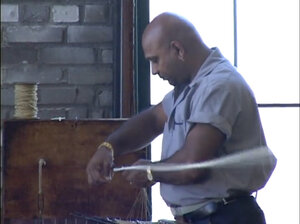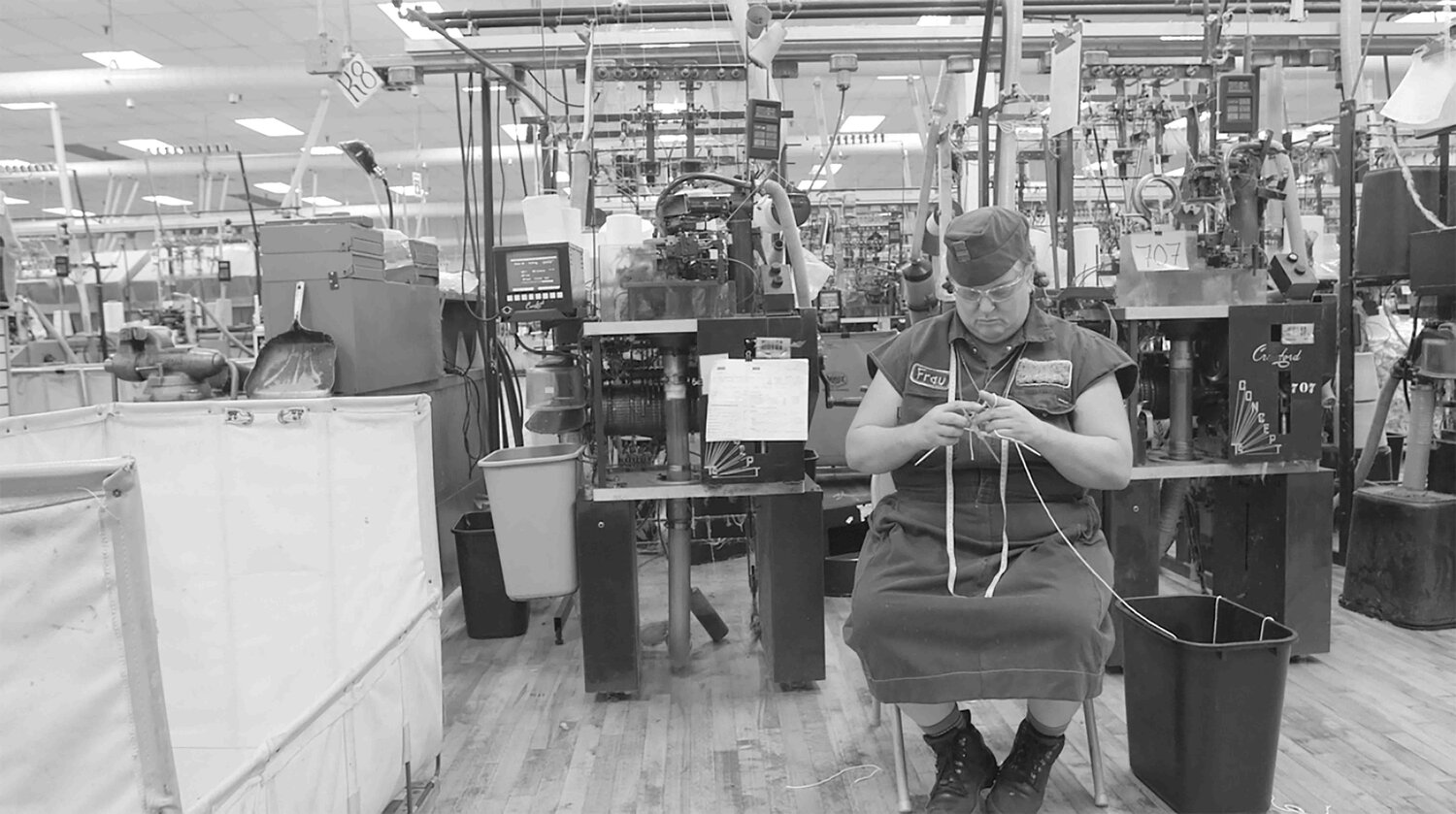Originally published on Good Trouble, November 11, 2019. Words by Alyssa Carter.
In her 1982 live performance, Martha Rosler famously donned a red jumpsuit and slowly sifted through the pages of Vogue. Rosler interjected the reading with her own narration and clips of garment workers with statistics about their working conditions and low wages and offered a second-wave feminist critique of the garment industry and the manipulation of women’s bodies in media. At the time of Martha Rosler Reads “Vogue”, the US was in the relatively early stages of its prodigious shift from primarily US-Based production. Now, nearly forty years later, 97% of the clothes sold in the United States are outsourced to nations the West deems as developing.
Fast Fashion/Slow Art (FF/SA) is a timely exhibition and catalogue that merges contemporary art and journalism to interrogate waste and consumerism in the garment industry, the cultural significance of which often gets unnoticed. Centering the intersectional issues of class, race, environmentalism and sexism, FF/SA is a collection of slow art—films, installations, and performances—that untangle (or perhaps discover the new tangles in) the nuanced threads of the societal condition that led us to mass textile production, or more aptly, fast fashion.
Fast fashion refers to the cycle of production, distribution, and marketing that both creates and feeds an appetite for the frequent consumption of and discarding of clothing; a binge consumption that can only survive on a diet of poor quality, high-speed manufacture and low wages. “The idea of slow art contrasts directly with the experience of fast fashion,” comments co-curator Phyllis Rosenzweig. Coined by the late Arden Reed, the idea of slow art is a direct provocation of the expeditious existence of modernity. What does it look like to walk slow and take note of your surroundings? To consume with curiosity and not just rapidity? “The show raises a lot of questions without necessarily providing solutions.” Rosenzweig continues: “Is the solution a return to pre-industrial working...is that even possible?”
“Approximately 85% of textile waste in the United States goes to landfills. More than 60% of fabric fibres are fossil-fuel derived synthetics, none of which will decay in a landfill.”
The impact of such insouciant materialism is very tangible. According to The New York Times, approximately 85% of textile waste in the United States goes to landfills. More than 60% of fabric fibres are fossil-fuel derived synthetics, none of which will decay in a landfill. It is not a far cry to imagine remnants of Zara and H&M tags embedded in future landscapes.
“It's the commodity fetish,” declares Bibiana Obler, co-curator of the exhibit. A sentiment echoed in Martin de Thurah’s Stories, a film that follows a young girl walking through Berlin, nonchalantly peeling off white t-shirts from herself one after another discarding them where they fall. Always another underneath like a Russian Doll, Thurah alludes both to the indispensability of the iconic white T and to their absolute disposability. On loop in the exhibition, the film calls attention to the unending, cyclical nature of consumerism.
“Producing just one of the cotton shirts in Thurah’s Stories requires 2,700 litres of water—the same amount of water one person drinks in nearly three years.”
Martin de Thurah, Stories, 2017, Video. Courtesy the artist and Epoch Films
When picturing the level of mass production required to generate fast fashion, one often imagines the quiet hum of a machine. Yet there is still a very human hand present in textile and garment production and distribution. Though the environmental perils of fast fashion are beginning to tickle the ears of the conscientious consumer, the arduous human labour rarely gets mentioned. In Wang Bing’s 15 Hours, a film that follows labourers from the beginning to the end of their 15-hour-workday, one of the workers says to another, “this stuff is so cheap, it's not worth making.” Co-curator Phyllis Rosenzweig ponders… “ how come so many artists now and historically have been so interested in portraying this kind of production?”
“Baig, among other garment workers, form a sort of choreography, rhythmically ensuring consistency in quality of work.”
This thin line between art and labour is alluring. Peering at the mesmerizing works in the show, often depicting monumental ribbons of cloth, and the tactful hand required to make the cloth, one can understand why an artist might find aesthetic parallels to their own work, as well as intellectual value in exploring these modes of production. Senga Nengudi’s The Threader focuses on the beauty and precision of the rhythmic movements of highly skilled textile employees, showing a relationship between this work and dance. Throughout her career, Nengudi frequently proclaims she has always wanted to be a dancer. In an interview with Elissa Auther, Nengudi explains: “I have a side interest in men at work and the rhythms and patterns they develop as part of physical labour. I was fascinated with the dance-like patterns of moves mill-worker Amir Baig maintained to assure the skillful accuracy of his task which was making cords and tassels.” Baig, among other garment workers, form a sort of choreography, rhythmically ensuring consistency in quality of work.

As many pieces in the exhibition depict the human hand in mass production, they also show humans being rapidly replaced by technological ability. Carole Frances Lung’s piece Frau Fiber vs. the Circular Knitting Machine hilariously plays in live time the four-hour-long competition between her persona Frau Fiber and industrial production. By the end of the four hours, she has successfully knitted a single sock while her competitor, the knitting machine, has made 99 pairs.

Carole Frances Lung, Frau Fiber vs. the Circular Knitting Machine, 2015, Digital video, black-and-white, sound, 4 hours, 32 minutes. Courtesy of ILGWU archive.
“How can we have more sustainable fashion?” Obler adds. “Slow Fashion. What does that look like?” Though very romantic, reverting back to our pre-industrial ways of knitting all of our own socks and weaving the cloth for our own garments, or spending the money on individuals who can do it for us is idealistic and expensive. FF/SA provokes the question of a more intentional existence. What does it look like to be conscientious consumers and change the path of fast fashion from a deplorable outpouring of waste to a humane and sustainable solution in our current moment?
At its crux, FF/SA is a reminder—an artistic resistance in the face of the consumerist mindset, where the first step requires a consideration, a slowing down.
FF/SA is on view at Luther W. Brady Art Gallery in DC through December 15, 2019. The exhibition will continue at The Bowdoin College Museum of Art in Brunswick, Maine from Jan 30 until August 2 2020.
Phyllis Rosenzweig is a seasoned curator emeritum at the Hirshhorn Museum and Sculpture Garden and self-proclaimed non-curator. Bibiana Obler is an associate professor of Art History at George Washington University. Artists include: Julia Brown, Martin de Thurah, Carole Frances Lung, Cat Mazza, Senga Nengudi, Martha Rosler, Hito Steyerl, Rosemarie Trockel, Wang Bing, and two documentaries—NPR’s Planet Money Makes a T-shirt and Sweatshop: Deadly Fashion.
ACTIONS
Check your tags when buying new clothing; try to avoid synthetic petrol-based fibres (Rayon, nylon, polyester, acrylic, and spandex). Buy second hand. Support makers who use clean supply chains. Mend what is broken. Learn how to repurpose.
Alyssa Carter is an artist based in Brooklyn. She uses performance, textiles, and painting/printmaking/collage techniques to explore intersections in identities, specifically black femmes.



